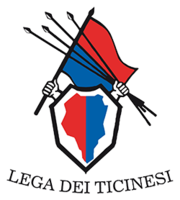Ticino League
Ticino League | |
|---|---|
 | |
| German name | Liga der Tessiner |
| French name | Ligue des Tessinois |
| Italian name | Lega dei Ticinesi |
| Founded | 1991 |
| Headquarters | Via Monte Boglia 3, CH-6900 Lugano |
| Membership (2015) | 1,500[1] |
| Ideology | Regionalism[2] Right-wing populism[2][3] Euroscepticism National conservatism Isolationism |
| Political position | Right-wing[4][5] |
| Colours | Blue, Red |
| National Council | 1 / 200 |
| Council of States | 0 / 46 |
| Cantonal Executives | 2 / 5 [a] |
| Cantonal legislatures | 18 / 90 [b] |
| Website | |
| lega-dei-ticinesi.ch | |
Swiss Federal Council Federal Chancellor Federal Assembly Council of States (members) National Council (members) Voting | |
The Ticino League (Italian: Lega dei Ticinesi) is a regionalist,[6] national-conservative political party in Switzerland active in the canton of Ticino.
In 1991, after some public campaigning in the Sunday journal against political power and use of public money, the editor Giuliano Bignasca and the director Flavio Maspoli founded the Ticino League to continue the fight at the political level. Bignasca (1945–2013) was the League's "president for life".
The League is one of four major parties in the canton, alongside FDP.The Liberals, the Christian Democratic People's Party, and the Social Democratic Party. Since 1991, the party has been represented in the National Council and in the five-member cantonal Ticino executive (the Council of State, Consiglio di Stato) with two seats. In the 90-seat Ticino legislature, (the Grand Council, Gran Consiglio) the party has 21 seats.
At the 2011 federal election, the party won 0.8% of the national popular vote and secured 2 out of 200 seats in the Swiss National Council (the first chamber of the Swiss parliament), doubling their representation compared to the single seat they held in 2007 with 0.5% of the vote.[7] In the 2015 election, the Ticino League slightly increased their share of the national vote to 1.0% and kept their two seats in parliament.[8] The party is not represented in the second chamber nor on the executive body of the nation.
The 2019 Swiss federal election cost the League one of its representatives in the National Council as was unable to hold her seat. was re-elected as the League’s sole representative in the Parliament.[9]
In the Federal Assembly, the League sits with the Swiss People's Party, and commentators see it as the Swiss Italian equivalent of the SVP.[10][11] A more notable political position of the League is its support for banning the Burqa, which it achieved in 2015.[10] It is also strongly eurosceptic, supporting Swiss sovereignty and reduced immigration.[12]
The League supports continued Ticino membership in Switzerland.[11] However, it supports the project of Insubria,[11] and it has some ties with the regional and federalist northern Italian rightist party Lega Nord.[11][better source needed]
Literature[]
- Mazzoleni, Oscar (2005). Multi-Level Populism and Centre-Periphery Cleavage in Switzerland: The Case of the Lega dei Ticinesi. Challenges to Consensual Politics: Democracy, Identity, and Populist Protest in the Alpine Region. Brussels: P.I.E.-Peter Lang. pp. 209–228.
See also[]
Notes[]
- ^ Total number of seats represents the Ticino Council of State, not the total number of cantonal executive seats in Switzerland.
- ^ Total number of seats represents the Grand Council of Ticino, not the total number of cantonal parliament seats in Switzerland.
References[]
- ^ The Swiss Confederation — A Brief Guide. Federal Chancellery. 2015. p. 21. Archived from the original (PDF) on December 20, 2016. Retrieved December 14, 2016.
- ^ Jump up to: a b Nordsieck, Wolfram (2019). "Switzerland". Parties and Elections in Europe. Retrieved 9 November 2019.
- ^ "Nationales Forschungsprogramm 40+".
- ^ Heiko Borchert (2013). "Switzerland and Europe's Security Architecture: The Rocky Road from Isolation to Cooperation". In Erich Reiter; Heinz Gärtner (eds.). Small States and Alliances. Springer Science & Business Media. p. 168. ISBN 978-3-662-13000-1.
- ^ The Swiss Confederation – a brief guide. Switzerland: Federal Chancellery, Communication Support, Swiss Confederation. 2016. p. 19. Archived from the original (PDF) on December 20, 2016. Retrieved December 11, 2016.
- ^ Damir Skenderovic (2009). The Radical Right in Switzerland: Continuity and Change, 1945-2000. Berghahn Books. pp. 114–122. ISBN 978-1-84545-580-4.
- ^ "Nationalrat 2007".
- ^ Bundesamt für Statistik. "Nationalratswahlen: Übersicht Schweiz". Retrieved 2015-10-19.
- ^ "La Lega si lecca le ferite, Quadri in lacrime". Corriere del Ticino (in Italian). 2019-10-20.
- ^ Jump up to: a b Schindler, John R. (July 12, 2016). "Swiss Italians Say No to the Burqa". Observer Media. Retrieved December 12, 2016.
- ^ Jump up to: a b c d Arroque, Stefano (June 1, 2016). "A Restive Canton: The Rise of Ticino's Own Lega". nationalia.info. Retrieved December 12, 2016.
- ^ Mombelli, Armando (July 25, 2015). "Small Parties of Protest and Principle". Swissinfo. Retrieved December 15, 2016.
External links[]
- Official website (in Italian)
- Political parties in Switzerland
- Political parties established in 1991
- Regionalist parties
- Right-wing populism in Switzerland
- Conservative parties in Switzerland
- Eurosceptic parties in Switzerland
- 1991 establishments in Switzerland
- National conservative parties
- Right-wing populist parties
- Western European political party stubs
- Switzerland politics stubs